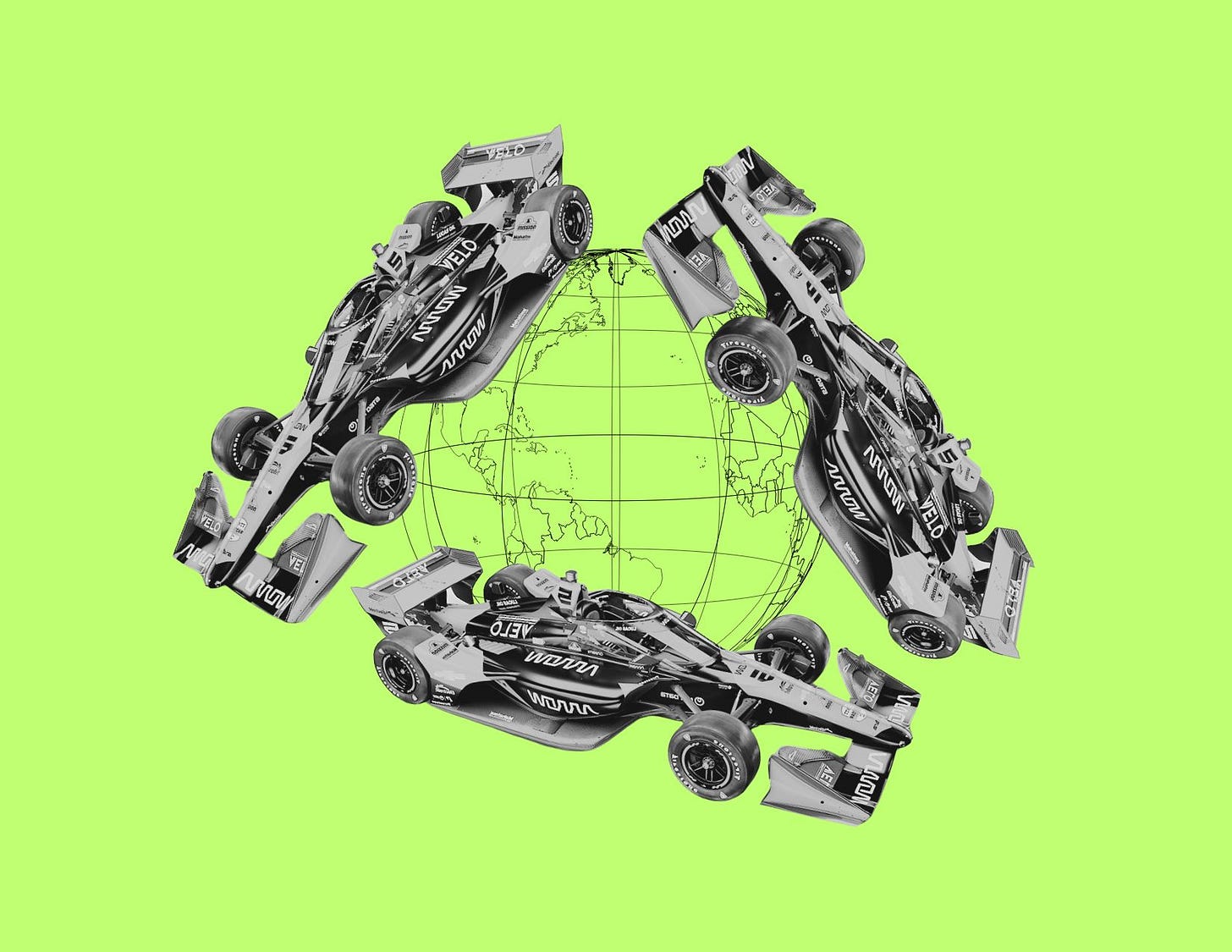Why Not Talking About Climate Change Could Be F1’s Key to Sustainability Success
Plus: Yuki Tsunoda’s big week and tariffs, tariffs and more tariffs
Welcome to The Undercut, a weekly newsletter round-up of the top storylines in racing brought to you by your favorite motorsport and enviro journo, Olivia Hicks. If you’re wondering “What the f*** is Formula 1?” Ask away! Leave a comment or send me a message with your burning questions.
Why Not Talking About Climate Change Could Be F1’s Key to Sustainability Success
My favorite environmental story doesn’t have anything to do with racing. Instead, it’s about Texas cattle ranchers. The two have more in common than you might think.
The story goes like this: In the heart of rural, conservative Texas oil country, one town became 100 percent powered by renewable energy. How? By local politicians and lobbyists never uttering the words “climate change.”
Formula 1 published its annual Impact Update in mid-March, tracking the sport’s environmental and social progress across 2024. The international racing series, flying to 21 countries over 10 months, has the unique challenge of becoming net-zero by 2030 with a global audience watching over its shoulder.
The 17-page report listed a series of highlights, including a 19 percent reduction in related travel emissions using DHL bio-fueled trucks and Sustainable Aviation Fuel (SAF). While the first report, spanning 63 pages and published in 2023, cited a 13 percent reduction in overall emissions and broke down the exact scope one, two and three emissions by source, Formula 1’s recent update failed to mention an overall percentage in emissions reduction and the sport’s total footprint from 2024.
Formula 1 insists it will hit its decarbonization deadline. And although carbon credits carry the weight of part of that goal, it is easy to see the racing series reaching it — armed with the best engineers that the sport’s billions of dollars can buy.
It’s harder to see where fans come in.
The inaugural report detailed how spectators “play a critical role in bringing these initiates to life and improving the event’s impact through their engagement,” including taking public transit to races and refilling reusable water bottles. But sitting fans down to “calculate travel emissions and contribute towards a cause that promotes change” looks more like a bandage when Formula 1’s business travel and logistics accounted for 78 percent of the sport’s 2022 carbon footprint.
The newly released document failed to detail how Formula 1 plans to engage fans in environmental education initiatives. However, that might not be such a bad thing. Unlike Formula E or Extreme E (now Extreme H) with built-in sustainability missions, racing series like Formula 1, IndyCar and NASCAR face an obstacle familiar to most industries: changing public opinion. And while electric racing competitions may be able to easily shout about rising sea levels, it could be in Formula 1’s best interest to keep its sustainability language strategic.
At the 2024 Indianapolis 500, I wrote about how IndyCar is doing just that. In an effort to change an event steeped in a tradition of gasoline, the racing series and speedway have kept sustainability measures behind the scenes.
Despite electrifying the sport, introducing 100 percent sustainable fuels in 2026 and welcoming an influx of young and diverse fans, Formula 1 is still largely traditional. Last month’s sudden calls for bringing back V10 engines only solidified that.
In Texas, talk of a warming globe didn’t encourage ranchers to invest in wind energy, cash did. For motorsport’s more skeptical fanbase and stakeholders, finding the right framing (straying away from paper straw lectures) could fast-track sustainability success.
A Promotion, a Home Race and a Fashion Line: It’s Yuki Tsunoda’s Week to Shine
Yuki Tsunoda will slip into a Red Bull at his home race this weekend. Sunday’s Japanese Grand Prix follows two weeks of seat swapping as Liam Lawson was demoted and Tsunoda took his place as Max Verstappen’s teammate. Lawson is the latest of many drivers within the energy drink-backed team subjected to Red Bull’s cut-throat approach. I wrote about the age-old question — is it the driver or the car? — for The Drive last week. In press sessions ahead of the race weekend, Tsunoda said he was confident in his abilities to wrangle the Red Bull: “If I didn’t have confidence, I wouldn’t be wearing this [Red Bull team kit]. I would have stayed in Racing Bulls.”
On top of a job promotion, Tsunoda launched a streetwear line on March 31. Ventidue (his race number, 22, in Italian) includes a combination of hoodies, beanies, sweats and jerseys. The business decision is a natural move for the Japanese driver who has been one of the fashionable few on race days.
What Do Trump’s “Liberation Day” Tariffs Mean For American Racing?
Cars driving in circles has always been an expensive business model and one that doesn’t always have a lot of returns. It’s about to get pricier.
President Donald Trump announced a string of tariffs on Wednesday that targeted foreign imports. The trade war, which Trump is calling a “declaration of economic independence,” will impact everyday Americans who buy everything from Australian beef to Chinese brake pads.
Just seven weeks ago, a dot of MAGA red stood out on the Daytona International Speedway’s black tarmac. “From the roar of the engines on the track to the echo of ‘The Star-Spangled Banner’ soaring through the stands, the Daytona 500 is a timeless tribute to the speed, strength and unyielding spirit that make America great,” Trump declared. “That spirit is what will fuel America’s Golden Age, and if we harness it, the future is truly ours.”
However, slapping a tax on imported goods, specifically a 25 percent tariff on all foreign auto parts, threatens to do the opposite of Trump’s promise of bolstering the motorsport industry. The auto tariffs will cover more than $460 billion worth of imported vehicles and parts, according to Reuters.
Read more about how this could impact a beloved American pastime here.
What I’ve been writing, reading and obsessed with this week:
Now+ (on tariffs and Canadian hockey media rights deals) - The Steve Dangle Podcast
Is Auston Matthews Back? - The Athletic’s The Leaf Report
Baseball Reaches Its Breaking Point - The New Yorker, Lindsey Adler
The Yankees’ Torpedo Bats Are a Formula 1 Moment in MLB - Neil’s Substack,
Why Aren’t Women Allowed to Play Baseball? - The Atlantic, Kaitlyn Tiffany
Anticipating more home runs this baseball season? It might be climate change. - NPR, Regina G. Barber










